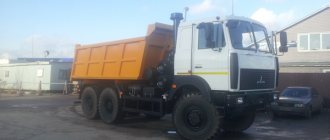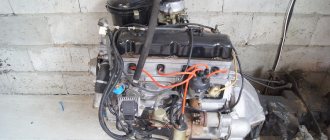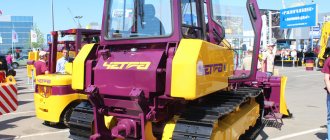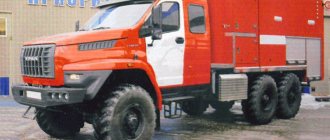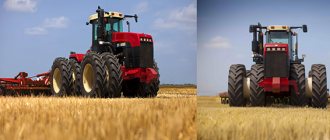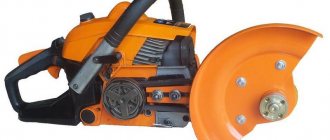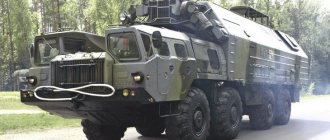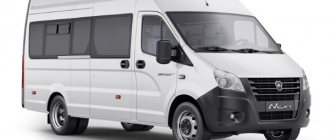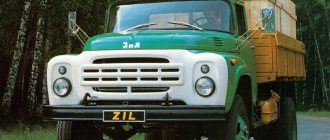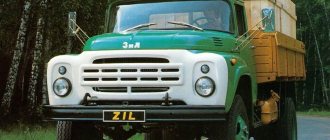Author: Vossen
04 September 2015 08:09
Tags: ZIL-135 ZIL history Soviet car
8622
35
5
Among the numerous off-road vehicles developed at SKB ZIL, this model had the happiest fate. The four-axle truck ZIL-135LM was mass-produced for about 30 years. Various weapons systems were installed on its chassis, which served in the Soviet army for a long time; such vehicles were exported to a number of countries.
0
See all photos in the gallery
ZIL-135LM with “mechanics” - as a substitute for ZIL-135L with “automation”
It was decided to produce the four-axle all-terrain truck developed and tested by ZIL designers at the Bryansk Automobile Plant, which was a secret defense enterprise in Soviet times. BAZ specialists proposed an alternative project of their own design - BAZ-930. However, comparative tests in early March 1962 showed the obvious advantages of the ZIL SUV truck. It was inferior to its competitor only due to its higher gas consumption. But in those days this did not matter much, and in all other respects the ZIL-135L was stronger.
That's right: the ZIL-135L, a more progressive car with a hydromechanical transmission, was initially accepted for production. However, problems arose with the production of the 135L model in Bryansk. There was no special technological equipment and qualified personnel for the production of automatic transmissions. It was necessary to expensively re-equip production, train new personnel, and correct the entire technical maintenance system in the troops.
No one bothered to do this: it was decided to use a conventional manual gearbox instead of an automatic hydromechanical transmission. Despite the protests of the chief designer of the ZIL-135L, Vitaly Grachev, who considered this decision a clear step back on the path of scientific and technological progress.
However, the ZIL-135L project was “put on the shelf”, and the first ZIL-135LM was assembled in Moscow in March 1963, retested and approved for mass production on October 12.
Practice, however, proved Grachev right, and this saving of public funds turned out to be imaginary. Manual transmissions have reduced the car's capabilities. The torque converters in the original version of the machine successfully compensated for the difference in the torque-speed characteristics of the two motors on the left and right sides. With a manual transmission, this was not possible: in order to ensure acceptable performance, complex adjustments were needed to the carburetors and ignition devices of the left and right side engines. This was the only way to achieve their synchronous operation, especially in transient conditions. And the two clutches also had to be adjusted to work synchronously, which also presented a big problem.
In practice, of course, no one in the troops did this. Therefore, the engines of most ZIL-135LM vehicles worked asynchronously: one motor was “leading” (developed excess power), and the other was “driven” (developed insufficient power). This led to premature wear of both power units. The “leader” was worn out due to overload, and the “follower”, which slowed down the “leader”, was worn out due to the oil being washed off from the cylinder walls by unburned gasoline. When starting from a standstill, the ZIL-135LM, due to the non-synchronous operation of the motors and clutches, turned to one of the sides, so a lot of skill was needed so as not to “drop” it when driving onto a railway platform or a narrow bridge.
In Afghanistan, where ZIL-135LM were transported by the Uragan RZSO, they tried to get rid of these shortcomings by installing one diesel engine instead of two gasoline engines - YaMZ-240, KamAZ-740 or 1D12 (with hydromechanical transmission) with a gearbox and side differential. But the differential, serving 4 axles at once, turned out to be bulky, heavy and unreliable.
Used by the following states[ | ]
The car is used by the following countries:
- Afghanistan
- Belarus
- China
- Cameroon
- Cuba
- Egypt
- Iran
- Libya
- North Korea
- Syria
- Ukraine
- Yemen
Ever used [ | ]
- Algeria
- Bulgaria (NRB)
- Czechoslovakia (Czechoslovakia)
- East Germany (GDR)
- Iraq
- Kuwait
- Poland (Poland)
- Romania (SRR)
- South Yemen
- USSR
- Yugoslavia (SFRY)
About the history of this model
The author of the 8x8 all-terrain vehicle project with a transmission scheme new for that time was V.A. Grachev. The novelty was that two engines, each through its own gearbox, drive the wheels of its side. This made it possible to do without complex and expensive differentials, transfer cases and additional gearboxes. This scheme also made it possible to maintain the vehicle’s mobility in the event of one of the engines failure.
The first samples of the ZIL-135 and the long-wheelbase variant ZIL-135B appeared in 1958-1959, and were amphibious vehicles. For the first time, they used the chassis design characteristic of the ZIL-135LM with shifted middle axles, separated by the front and rear, and steered wheels of the front and rear axles. Also on these all-terrain vehicles, an on-board transmission scheme with two engines was tested, one of which rotated the wheels on the left side, and the second on the right side.
But it was not possible to obtain an all-terrain floating missile-carrying vehicle (which is what four-axle chassis were developed for in the first place). Without the superstructure she swam quite well. But when they installed the S-121 ballistic installation manufactured in Volgograd and sent it equipped to sail along the Don, the crew experienced a thrill: on the water the truck behaved extremely unstable, strove to capsize or roll over. Therefore, they decided that launching a rocket from an amphibian floating on water was dangerous - most likely, this launch would drown or overturn the car.
They abandoned amphibians, returning to their development only in the second half of the 60s: they decided to make the four-axle all-terrain vehicle non-floating. Test launches revealed another problem: the shock wave from the take-off rocket crushed and disfigured the metal cab of the truck. This was corrected by the decision to make cabins for mobile missile systems from fiberglass. When the rocket took off from the pressure of the powder gases, this material also crumpled, but, unlike metal, it then regained its original shape.
Two ZIL-135E cars, manufactured in 1960, were already similar to production ones. However, like their floating predecessors, they lacked suspension: all wheels were rigidly attached to the frame. Tests have shown the unsatisfactory nature of this design.
Therefore, at the beginning of April 1961, the first sample of the ZIL-135L all-terrain vehicle was created, equipped with a suspension of the front and rear wheels on wishbones and longitudinal torsion bars. The middle pairs of wheels were left rigidly connected to the frame. The introduction of suspension led to changes in steering parts, additional strengthening and narrowing of the frame by 186 mm.
This modification was tested as a base for a missile launcher, a transport-loading vehicle, and a civilian version for extreme off-road use: a flatbed truck, a universal chassis, and a pipe tractor.
The equipping of troops with Luna-M missile systems and Uragan multiple rocket launchers determined the stable serial production of the ZIL-135LM chassis in Bryansk in the 70-80s. Flatbed vehicles, tractors and pipe tractors, and fire trucks were produced in smaller quantities. The model continued to roll off the assembly line until the collapse of the USSR, and in 1993 its production was finally interrupted.
In 1964-1965, the Likhachev Plant successfully tested the modified ZIL-135L in the version of a pipe carrier and the ZIL-135LM with an onboard platform. The machines were tested in opposite extreme conditions: during the construction of gas pipelines in the sands of the Central Asian Soviet republics, as well as in winter in the north of the Tyumen region, during the construction of the Shaim-Tyumen oil pipeline. The positive results of using the ZIL-135LM chassis in the national economy gave rise to the Bryansk Automobile Plant to produce an industrial batch of “civilian” vehicles in 1966, under the name BAZ-135L4 “Novator”, with a load capacity of 9 tons. These cars were exhibited in the summer of 1968 at the Exhibition of Achievements of the National Economy in Moscow. However, it did not come to the mass production of civilian versions of this off-road four-axle vehicle.
Beginning in 1968, the ZIL-135LM chassis was supplied in small quantities to the Warsaw Pact countries and the allied states of Asia and Africa, for which a tropical version of the vehicle was specially developed. Export deliveries were most intense until the mid-1970s, and a total of 210 chassis of the 135 series went abroad. In total, over all the years of mass production in Bryansk, more than 5 thousand ZIL-135LM vehicles were produced.
ZIL-135LM trucks, especially civilian versions, have become a rarity these days. Some examples of trucks of this family have been deliberately preserved for history as museum exhibits. The Military Technical Museum near Moscow displays a ZIL-135LM, which worked at the Likhachev Plant as a tow truck for large-sized equipment.
Design features: layout, power section
Behind the streamlined fiberglass cabin there are two parallel 180-horsepower ZIL-375YA gasoline engines, weighing 530 kg each. They were equipped with their own liquid pre-heaters, power, lubrication and cooling systems with longitudinal side radiators and forced circulation of coolant.
From both power units, torque through two dry double-disc clutches (with hydraulic control from one pedal) and through two 5-speed YaMZ-204U gearboxes (as on Ural-375 trucks) and two single-stage transfer boxes was supplied to two on-board single-stage systems bevel and cylindrical wheel gearboxes. To simultaneously control both systems, special synchronizing devices were developed.
Both five-speed gearboxes also had the original remote control from a cab-mounted rocker. The control drive of one of the gearboxes could be switched off in case of engine failure.
For the first time, an electronic shielded ignition system was used on ZIL-135LM engines. All systems allowed separate operation of power units; if one of them failed, the truck could confidently reach the base without losing much in speed and maneuverability.
The locked longitudinal drive of the wheels on each side from its own engine consisted of a single-stage three-shaft transfer case, with the ability to take power to drive additional units (generators, winches, water jets); 4 onboard bevel gearboxes connected to each other in one line by three cardan shafts, and 4 eccentric ones (in order to increase the clearance of the wheel spur gearboxes, on the support axes of which the bearings and hubs of all drive wheels sat).
Next, behind the cabin and engines, an open part of the welded spar frame was located, intended for the installation of special equipment. Its installation length was 5200 mm, and its loading height was 990 mm.
Design features: suspension, chassis
The unsteered middle axles were rigidly fixed to the frame, and the outer front and rear steered pairs of wheels were equipped with an independent torsion bar suspension with double-acting telescopic hydraulic shock absorbers. By means of steering (with a hydraulic booster), they could deviate in different directions. To change the air pressure in all diagonal tube tires of size I-159 16.00-20, a centralized inflation system was used, with a control unit from the driver’s cabin.
The drive axles were placed unevenly - the second and third axles of the car were brought together, and the two outer axles were spaced apart.
Placing unsteered axles near the center of mass of the vehicle reduced the power required to overcome resistance when cornering; improved profile cross-country ability - the car was capable of overcoming obstacles such as ditches and trenches.
The rear and front wheels were steerable and could turn in opposite directions, which contributed to a significant improvement in the vehicle's handling and maneuverability, and when turning, the rear wheels followed exactly the track of the front ones. On a hard ground surface, the ZIL-135LM vehicle could continue to move in the absence of any of its two wheels.
The wheel gearboxes of the middle non-steerable wheels were rigidly connected to the frame with cast brackets made of magnesium alloy, and their drive shafts did not have cardan joints. The gearboxes of the steered wheels were equipped with independent torsion bar suspensions on two wishbones, as well as powerful tank hydraulic shock absorbers (the full travel of the wheels was 172 mm, and more was not needed), and were driven into rotation by swinging axle shafts with synchronous ball joints of the “Rtseppa” type (later they were converted into "Birfield" type hinges).
Soft and thin-walled large-section tires I-159 measuring 16.00-20″ with adjustable internal air pressure from 0.5 to 2.5 kgf/cm2, were mounted on split rims, and had developed “split herringbone” lugs. They self-cleaned very well, allowed double overload and operation without damage when elastic deformations occurred, amounting to up to half of the entire profile height.
Steering and brake controls, electrical equipment
The rotation of the front and rear wheels (in mutually opposite directions) was rigid, kinematically connected to each other by a system of longitudinal and transverse steering rods. The reversible power steering included 2 power hydraulic cylinders, which were fed through a common control spool from 2 hydraulic pumps with separate drives from each engine. The failure of one of them did not lead to an increase in the forces on the steering wheel (the angular speed of the wheels was only reduced by half). It is important that when turning the ZIL-135LM on soft ground, only 2 tracks appeared, while other 4-axle vehicles with a traditionally controlled front pair of wheels had three tracks.
The hydraulic part of the pneumatic-hydraulic drive of the service brakes was double-circuit (with two pneumatic boosters); mechanically controlled parking drum brakes were located in the front final drive gearboxes.
The single-wire shielded electrical equipment with a voltage of 24 Volts included 4 batteries, 2 generators with a power of 6.5 kW each and 2 starters of 1.5 kW each. The cabin was equipped with two front blackout lights and a left search light.
First developments
ZIL 135, a photo of which can be seen in our article, was developed for several years before the first truck of this brand was created. Military truck designs began to be designed for the first time back in 1955. This equipment was ordered by the leadership of the USSR. The first prototype of the ZIL was the ZIS-E134 model. Instead of the usual design that was produced at this plant, the car received some improvements. So, it had 4 axles. It was planned to include a 130 hp engine in the vehicle. p., hydraulic booster and torque converter. A tire pressure regulation system was also developed.
A year later, the second layout was assembled. It was a military low-profile transport. He gained the ability to move on water. For this purpose, a development such as water-jet propulsion was used. This system was the same as that of the PT-76 tanks. The model of the car had a metal body. The engine in development had a power of 120 hp. With. 2 hydraulic boosters were installed on the steering mechanism. It was here that the suspension was abolished. Tests of the model showed what changes needed to be made to the design.
The ZIL 135 model was developed somewhat later. Based on the created model, the ZIL 134 model was developed. It looked vaguely similar to the 135 model. The new development received two engines with a total power of 240 hp. With. The engine had a total of 12 cylinders. Also included in the design was a unique hydromechanical suspension. Also, torsion bar suspensions were installed on all wheels. This vehicle could carry up to 4 thousand kg of cargo (or 8 people). The vehicle moved on water by rotating the wheels. At the same time, it developed a speed of 2 km/h.
The preliminary development, which was the 134 model, was divided into 2 categories. The first of them was used for general purposes. The second one was marked with the letter “A”. This modification was used at airfields. This vehicle could transport aircraft along the runway with a loaded body.
However, tests revealed many shortcomings. The 134 model has undergone major modifications. Work on this modification has stopped. Instead, the designers' efforts were aimed at developing the 135 model. She was more perfect.
Cabin ZIL-135LM
The two-door, four-seater cabin, weighing 490 kilograms, was equipped with an adjustable driver's seat, an autonomous heater, radiation monitoring equipment, and special places for attaching personal weapons. In the rear of the cabin, between the cooling radiators, three fuel tanks were installed - a main 300-liter tank and two additional 110-liter tanks.
Engines ZIL-135LM
Behind the cabin and the adjacent gas tanks was the engine compartment of the car, in which two carburetor V-shaped 8-cylinder ZIL-375Ya engines with a power of 180 horsepower each were installed in parallel. On the sides of the engine compartment there were two radiators of the cooling system, the fans of which were each driven by its own engine. The latter also drove 2 powerful tank electric generators.
The valves in the cylinders of this engine are located at the top. ZIL-375Ya was used, in particular, for installation on Ural-375 trucks, LiAZ-677 buses and their modifications. It is also available in a tropical version (ZIL-375YA7T) - especially for use in countries with dry and humid tropical climates.
The technical parameters of each ZIL-375Ya engine are as follows:
- Cylinder displacement – 7 liters (7000 cm³);
- Cylinder diameter – 108 mm, piston stroke – 95 mm;
- Compression ratio – 6.5.
- Rated power, at 3200 min-1 – 132.4 kW (180 hp);
- Maximum torque, at 1800-2000 min-1 – 465.8 N.m (47.5 kgf.m);
- Minimum idle speed – 400…500 min-1;
- Maximum idle speed – 3450 min-1;
- Cylinder operating order: 1-5-4-2-6-3-7-8;
- Allowable engine roll angles: longitudinal – 25°, transverse – 20°.
- The weight of the unlubricated engine, without gearbox, is 460 kg.
Tropical option
For countries with a tropical climate, a special export version of the ZIL-135 LMT was created. The main difference between this instance and the base vehicle is the enhanced cooling system, as well as specially designed sealed electrical equipment. The appearance also changed, the ZiL was painted sand color. Along with all the changes, the program also included a specialized chassis with two batteries. It is worth noting that the base machine has four batteries. The design has changed, as well as the fastening of the covers in the engine compartment. These fastenings are necessary for the installation of an additional charging machine of the TZM 9T29 brand.
Vehicle specifications in numbers
- Overall dimensions: length 9270 mm, width 2800 mm, height 2530 mm.
- Wheelbase: 2400+1500+2400 mm.
- Track width: 2300 mm.
- Curb weight of the vehicle: 10,500 kg, gross weight: 19,800 kg.
- Car load capacity: 9000 kg.
- Ground clearance: 589 mm.
- Turning radius: 12.5 m.
- Obstacles to be overcome: trench - 3.6 m, vertical wall - 0.9 m, ford - 1.3 m, longitudinal rise - 28 degrees, lateral roll - 20 degrees.
- Total capacity of fuel tanks: 520 liters of gasoline.
- Maximum speed: 65 km/h (when driving on the highway).
- Control gasoline consumption: 88 liters per 100 km, operating consumption – in the range of 125-200 liters.
- Power reserve is approximately 500 km. Warranty mileage – 15 thousand km.
All ZIL-135LM trucks were adapted for transportation by rail and in the cargo compartments of Il-76 and An-22 transport aircraft, for operation on all types of roads and completely off-road, at temperatures from -40 to +40 degrees, including including at high humidity or dust, and at altitudes up to 3000 meters above sea level.
ZIL-135LM became the first serial four-axle military vehicle of the middle category in the Soviet Union, which for the first time used a fiberglass cabin, an engine compartment block with linings for radiators and fuel tanks, wheel fenders, containers for batteries and other products.
For the first time in automotive practice, the ZIL-135LM used so widely body and power panels made of fiberglass - a material that is more durable, elastic and fire-resistant compared to sheet metal. In addition to the cabin and gas tanks, in this car all the external parts of the engine compartment, its hoods, wheel fenders, running boards, front bumper (initially), battery box, split wheel rims (not on all cars) were made from it. They even made an experimental frame with a honeycomb structure from fiberglass. The adoption of such a bold, truly revolutionary decision at the turn of the 50s and 60s was the undoubted merit of domestic designers and the priority of our country.
The ZIL-135LM car embodied many bold and original ideas for all-wheel drive all-terrain vehicles, which were subsequently used to create powerful artillery and missile systems. At one time, they had no direct foreign analogues and clearly demonstrated the inexhaustible creative scientific, technical and financial capabilities of the advanced Soviet automobile industry.
Links
All terrain ZIL-157 • ZIL-131 • ZIL-135 • ZIL-4334 • ZIL-49061 Executive models ZIL-111 • ZIL-114 • ZIL-117 • ZIL-4104 • ZIL-41045 • ZIL-41047 • ZIL-4105 “Armored Capsule” • ZIL-4112R Buses and special equipment V-1 • ZIL-112S • ZIL-118 • ZIL-158 (LiAZ-158) • ZIL-134 • ZIL-E167 • ZIL-170 • ZIL-2906 Post-war BKM and military vehicles of the USSR, Ukraine and Russia p • o • r
Trucks MAZ-502 • ZIS-151 • ZIL-131 • ZIL-157 • ZIL-135 • ZIL -4334 • GAZ-63 • GAZ-66 • GAZ-33097 • Ural-375D • Ural-4320 • Ural-5323 • KrAZ- 214 • KrAZ-255B • KrAZ-260 • KrAZ-5233 • KAMAZ-4310 • KAMAZ 6350 • KAMAZ 63501 Armored personnel carriers BTR-40 • BTR-50 • BTR-60 • BTR-70 • BTR-80 • BTR-90 • BTR-152 • BTR-D Armored reconnaissance vehicles Artillery tractors and other vehicles BRDM-1 • BRDM-2 • BRM-1K • BRM-3K AT-S • ZIS-485 • ATS-59G • AT-P • MT-LB • PTS • AT-T • MT-T • AT-L • GAZ-69 • UAZ-469 • LuAZ-967 • “Progress”
